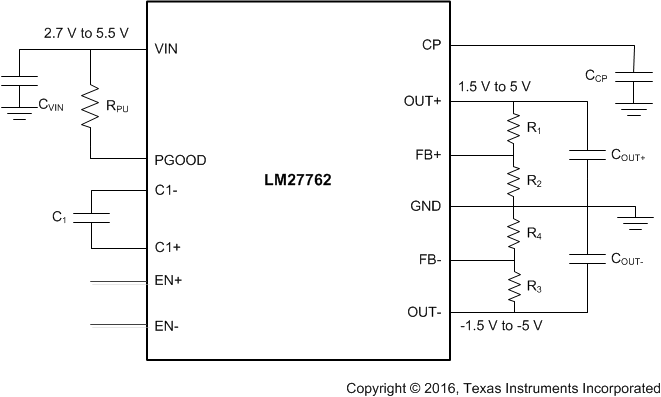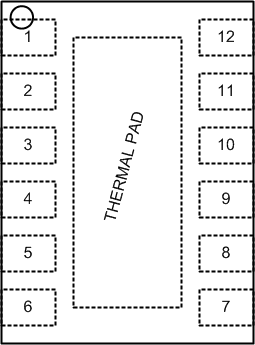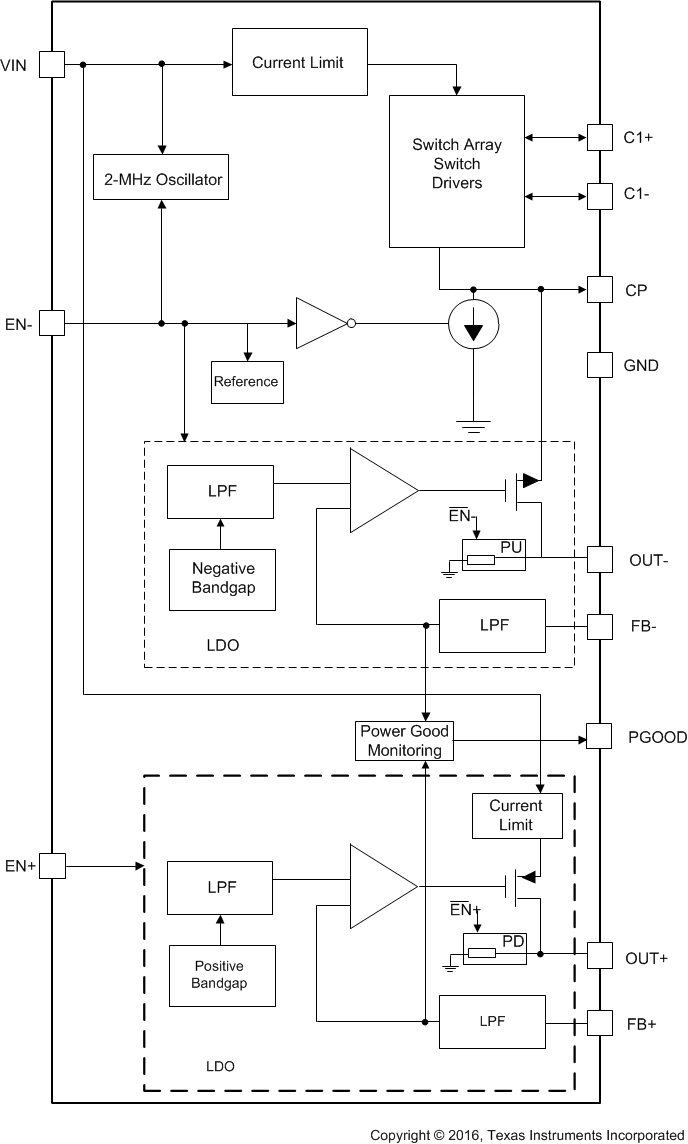-
LM27762 Low-Noise Positive and Negative Output Integrated Charge Pump Plus LDO
- 1 Features
- 2 Applications
- 3 Description
- 4 Revision History
- 5 Pin Configuration and Functions
- 6 Specifications
- 7 Detailed Description
-
8 Application and Implementation
- 8.1 Application Information
- 8.2
Typical Application
- 8.2.1 Design Requirements
- 8.2.2 Detailed Design Procedure
- 8.2.3 Application Curves
- 9 Power Supply Recommendations
- 10Layout
- 11Device and Documentation Support
- 12Mechanical, Packaging, and Orderable Information
- IMPORTANT NOTICE
LM27762 Low-Noise Positive and Negative Output Integrated Charge Pump Plus LDO
1 Features
- Generates Low-Noise Adjustable Positive Supply Voltage Between 1.5 V and 5 V and Negative Supply Voltage Between –1.5 V and –5 V
- Input Voltage Range 2.7 V to 5.5 V
- ±250-mA Output Current
- Inverting Charge Pump Followed by Negative LDO
- 2-MHz Low-Noise Fixed-Frequency Operation
- 2.5-Ω Inverter Output Impedance, VIN = 5 V
- Negative LDO Dropout Voltage 30 mV at 100 mA, VOUT = –5 V
- Positive LDO with 45-mV Dropout Voltage at 100 mA, VOUT = 5 V
- 390-µA Quiescent Current (Typical)
- Shutdown Quiescent Current to 0.5 µA (Typical)
- Current Limit and Thermal Protection
- Power Good Pin (Active Low)
- Create a Custom Design Using the LM27762 With the WEBENCH® Power Designer
2 Applications
- Hi-Fi Audio Headphone Amplifiers
- Operational Amplifier Power Biasing
- Powering Data Converters
- Wireless Communication Systems
- Interface Power Supplies
- Handheld Instrumentation
3 Description
The LM27762 delivers very low-noise positive and negative outputs that are adjustable between ±1.5 V and ±5 V. Input-voltage range is from 2.7 V to 5.5 V, and output current goes up to ±250 mA. With an operating current of only 390 µA and 0.5-µA typical shutdown current, the LM27762 provides ideal performance for power amplifier and DAC bias and other high-current, low-noise negative voltage needs. The device provides a small solution size with few external components.
Negative voltage is generated by a regulated inverting charge pump followed by a low-noise negative LDO. The inverting charge pump of the LM27762 device operates at 2-MHz (typical) switching frequency to reduce output resistance and voltage ripple. Positive voltage is generated from the input by a low-noise positive LDO.
Positive and negative outputs of LM27762 have dedicated enable inputs. These outputs support independent timing for the positive and negative rails for specific system power-sequence needs. Enable inputs can be also shorted together and connected to the input voltage. The LM27762 has an optional Power Good feature.
Device Information(1)
| PART NUMBER | PACKAGE | BODY SIZE (NOM) |
|---|---|---|
| LM27762 | WSON (12) | 2.00 mm × 3.00 mm |
- For all available packages, see the orderable addendum at the end of the data sheet.
space
Simplified Schematic

4 Revision History
Changes from A Revision (September 2016) to B Revision
- Added added ulinks for WEBENCH Go
Changes from * Revision (July 2016) to A Revision
- Changed "Switched Capacitor" to "Charge Pump" in title Go
- Changed "Generates Low-Noise Adjustable Positive and Negative Supply Voltages From ±1.5 V and ±5 V" to "Generates Low-Noise Adjustable Positive Supply Voltages Between 1.5 V and 5 V and Negative Supply Voltages From –1.5 V to –5 V" in FeaturesGo
5 Pin Configuration and Functions

Pin Functions
| PIN | TYPE | DESCRIPTION | |
|---|---|---|---|
| NAME | NUMBER | ||
| C1+ | 10 | Power | Positive terminal for C1 |
| C1– | 9 | Power | Negative terminal for C1 |
| CP | 5 | Power | Negative unregulated output voltage |
| EN+ | 12 | Input | Enable input for the positive LDO, Active high |
| EN– | 8 | Input | Enable input for the charge pump and negative LDO, Active high |
| FB+ | 2 | Power | Feedback input. Connect FB+ to an external resistor divider between OUT+ and GND. DO NOT leave unconnected. |
| FB– | 7 | Power | Feedback input. Connect FB– to an external resistor divider between OUT– and GND. DO NOT leave unconnected. |
| GND | 4 | Ground | Ground |
| OUT+ | 11 | Power | Regulated positive output voltage |
| OUT– | 6 | Power | Regulated negative output voltage |
| PGOOD | 1 | Output | Power Good flag; open drain; Logic 0 = power good, Logic 1 = power not good. Connect to ground if not used. |
| VIN | 3 | Power | Positive power supply input |
| Thermal Pad | — | Ground | Ground. DO NOT leave unconnected. |
6 Specifications
6.1 Absolute Maximum Ratings
over operating free-air temperature range (unless otherwise noted)(1)(2)| MIN | MAX | UNIT | ||
|---|---|---|---|---|
| VIN to GND or GND to VOUT | 5.8 | V | ||
| EN+, EN- | GND − 0.3 | VIN | V | |
| CPOUT, OUT+ and OUT- , continuous output current | 300 | mA | ||
| OUT+, OUT- short-circuit duration to GND(3) | 1 | s | ||
| Continuous power dissipation(4) | Internally limited | |||
| TJMAX(4) | 150 | °C | ||
| Operating input voltage, VIN | 2.7 | 5.5 | V | |
| Operating output current, IOUT | 0 | 250 | mA | |
| Operating ambient temperature, TA | –40 | 85 | °C | |
| Operating junction temperature, TJ | –40 | 125 | °C | |
| Storage temperature, Tstg | –65 | 150 | °C | |
6.2 ESD Ratings
| VALUE | UNIT | |||
|---|---|---|---|---|
| V(ESD) | Electrostatic discharge | Human-body model (HBM), per ANSI/ESDA/JEDEC JS-001(1) | ±1000 | V |
| Charged-device model (CDM), per JEDEC specification JESD22-C101(2) | ±250 | |||
6.3 Recommended Operating Conditions
over operating free-air temperature range (unless otherwise noted)| MIN | MAX | UNIT | ||
|---|---|---|---|---|
| Operating ambient temperature, TA | –40 | 85 | °C | |
| Operating junction temperature, TJ | –40 | 125 | °C | |
6.4 Thermal Information
| THERMAL METRIC(1) | LM27762 | UNIT | |
|---|---|---|---|
| DSS (WSON) | |||
| 12 PINS | |||
| RθJA | Junction-to-ambient thermal resistance | 62.2 | °C/W |
| RθJC(top) | Junction-to-case (top) thermal resistance | 54.7 | °C/W |
| RθJB | Junction-to-board thermal resistance | 25.6 | °C/W |
| ψJT | Junction-to-top characterization parameter | 1.8 | °C/W |
| ψJB | Junction-to-board characterization parameter | 25.6 | °C/W |
| RθJC(bot) | Junction-to-case (bottom) thermal resistance | 9.2 | °C/W |
6.5 Electrical Characteristics
Typical limits apply for TA = 25°C; minimum and maximum limits apply over the full temperature range. Unless otherwise specified VIN = 5 V, CIN = COUT+ = COUT– = 2.2 μF, C1 = 1 μF, CPOUT = 4.7 μF.| PARAMETER | TEST CONDITIONS | MIN | TYP | MAX | UNIT | |
|---|---|---|---|---|---|---|
| IQ | Supply current | Open circuit, no load, EN+, EN– connected to VIN. (1) | 390 | µA | ||
| ISD | Shutdown supply current | 0.5 | 5 | µA | ||
| ƒSW | Switching frequency | VIN = 3.6 V | 1.7 | 2 | 2.3 | MHz |
| RNEG | Output resistance to CPOUT | VIN = 5.5 V, IL = 100 mA | 2.5 | Ω | ||
| VLDO– | LDO dropout voltage | IL = 100 mA, VOUT– = −5 V | 30 | mV | ||
| PSRR | Power supply rejection ratio, OUT– | IL = 100 mA, VOUT– = −1.8 V, 10 kHz | 50 | dB | ||
| VN– | Output noise voltage | IL = 80 mA, 10 Hz to 100 kHz | 22 | µVRMS | ||
| VFB– | Feedback pin reference voltage | –1.238 | –1.22 | –1.202 | V | |
| VOUT– | Adjustable output voltage | 5.5 V ≥ VIN ≥ 2.7 V | –5 | –1.5 | V | |
| Load regulation | 0 to 250 mA, VOUT = –1.8 V | 34 | µV/mA | |||
| Line regulation | 5 V ≥ VIN ≥ 2.7 V, IL = 50 mA | 1.5 | mV/V | |||
| VLDO+ | LDO dropout voltage | IL = 100 mA, VOUT = 5 V | 45 | mV | ||
| PSRR | Power supply rejection ratio, OUT+ | IL = 100 mA, VOUT+ = 1.8 V, 10 kHz | 43 | dB | ||
| VN+ | Output noise voltage | IL = 80 mA, 10 Hz to 100 kHz | 22 | µVRMS | ||
| VFB+ | Feedback pin reference voltage | 1.182 | 1.2 | 1.218 | V | |
| VOUT+ | Adjustable output voltage | 5.5 V ≥ VIN ≥ 2.7 V | 1.5 | 5 | V | |
| Load regulation | 0 to 250 mA, VOUT = 1.8 V | 11 | µV/mA | |||
| Line regulation | 5 V ≥ VIN ≥ 2.7 V, IL = 50 mA | 1.9 | mV/V | |||
| VIH | Enable pin input voltage high | 5.5 V ≥ VIN ≥ 2.7 V | 1.2 | V | ||
| VIL | Enable pin input voltage low | 5.5 V ≥ VIN ≥ 2.7 V | 0.4 | V | ||
6.6 Typical Characteristics

| VIN = 3.7 V | VOUT = ±3 V | |

| VOUT = ± 3.3 V | ||

| VOUT = –3.3 V | ||

| VIN = 4.3 V | VOUT = –3.3 V | |

| VIN = 5.5 V | ||


| VOUT = ±3 V | IOUT = ±100 mA | |

| VIN = 5.5 V | ||

| VOUT = 3.3 V | ||

| VIN = 4.3 V | VOUT = 3.3 V | |

7 Detailed Description
7.1 Overview
The LM27762 low-noise inverting charge pump with both positive and negative LDOs delivers very low-noise adjustable positive and negative outputs between ±1.5 V and ±5 V. The output voltage levels of the positive and negative LDO are independently controllable with external resistors. Input voltage range of LM27762 is from 2.7 V to 5.5 V. Five low-cost capacitors are used in this circuit to provide up to ±250 mA of output current. The LM27762 operates at 2-MHz (typical) switching frequency to reduce output resistance and voltage ripple. With an typical operating current of only 390 µA and 0.5-µA typical shutdown current, the LM27762 provides ideal performance for power amplifiers and DAC bias and other high-current, low-noise negative voltage needs.
The LM27762 device has an enable input (EN+) for the positive LDO and another enable input (EN–) for the negative charge pump and LDO. This supports independent timing for the positive and negative rails in system power sequence. Enable inputs can be also shorted together and connected to VIN. When LDO is disabled, output of the positive LDO has 50-kΩ pulldown to ground, and output of the negative LDO has 50-kΩ pullup to ground. The LM27762 has power good monitoring for OUT+ and OUT– outputs. The PGOOD pin is an open-drain output and requires an external pullup resistor. When Power Good feature is not used, PGOOD pin can be connected to ground.
7.2 Functional Block Diagram

7.3 Feature Description
7.3.1 Undervoltage Lockout
The LM27762 has an internal comparator that monitors the voltage at VIN and forces the device into shutdown if the input voltage drops to 2.4 V. If the input voltage rises above 2.6 V, the LM27762 resumes normal operation.
7.3.2 Input Current Limit
The LM27762 contains current limit circuitry that protects the device in the event of excessive input current and/or output shorts to ground. The charge pump and positive LDO both have 500 mA (typical) input current limit when the output is shorted directly to ground. When the LM27762 is current limiting, power dissipation in the device is likely to be quite high. In this event, thermal cycling is expected.
7.3.3 PFM Operation
To minimize quiescent current during light load operation, the LM27762 allows PFM or pulse-skipping operation. By allowing the charge pump to switch less when the output current is low, the quiescent current drawn from the power source is minimized. The frequency of pulsed operation is not limited and can drop into the sub-2-kHz range when unloaded. As the load increases, the frequency of pulsing increases until it transitions to constant frequency. The fundamental switching frequency in the LM27762 is 2 MHz.
7.3.4 Output Discharge
In shutdown, the LM27762 actively pulls down on the outputs (OUT+, OUT–) of the device until the output voltage reaches GND.
7.3.5 Power Good Output (PGOOD)
The LM27762 has monitoring for the OUT+ and OUT– output voltage levels and open-drain PGOOD output.
Table 1. PGOOD (Active Low) Operation
| EN+ | EN– | OUT+ | OUT– | PGOOD |
|---|---|---|---|---|
| Low | Low | Don't care | Don't care | High |
| High | Low | < 95% of target value | Don't care | High |
| High | Low | > 95% of target value | Don't care | Low |
| Low | High | Don't care | < 95% of target value | High |
| Low | High | Don't care | > 95% of target value | Low |
| High | High | < 95% of target value | Don't care | High |
| High | High | Don't care | < 95% of target value | High |
| High | High | > 95% of target value | > 95% of target value | Low |
7.3.6 Thermal Shutdown
The LM27762 implements a thermal shutdown mechanism to protect the device from damage due to overheating. When the junction temperature rises to 150°C (typical), the device switches into shutdown mode. The LM27762 releases thermal shutdown when the junction temperature is reduced to 130°C (typical).
Thermal shutdown is most often triggered by self-heating, which occurs when there is excessive power dissipation in the device and/or insufficient thermal dissipation. The LM27762 device power dissipation increases with increased output current and input voltage. When self-heating brings on thermal shutdown, thermal cycling is the typical result. Thermal cycling is the repeating process where the part self-heats, enters thermal shutdown (where internal power dissipation is practically zero), cools, turns on, and then heats up again to the thermal shutdown threshold. Thermal cycling is recognized by a pulsing output voltage and can be stopped by reducing the internal power dissipation (reduce input voltage and/or output current) or the ambient temperature. If thermal cycling occurs under desired operating conditions, thermal dissipation performance must be improved to accommodate the power dissipation of the device.
7.4 Device Functional Modes
7.4.1 Shutdown Mode
When enable pins (EN+, EN–) are low, both positive and negative outputs of LM27762 are disabled, and the device is in shutdown mode reducing the quiescent current to minimum level. In shutdown, the outputs of the LM27762 are pulled to ground (internal 50 kΩ between each OUT pin and ground).
7.4.2 Enable Mode
Applying a voltage greater than 1.2 V to the EN+ pin enables the positive LDO. Applying a voltage greater than 1.2 V to the EN– pin enables the negative CP and LDO. When enabled, the positive and negative output voltages are equal to levels set by external resistors. Care must be taken to both the positive LDO and the inverting charge pump followed by negative LDO have enough headroom. Power Good ouput PGOOD indicates the status of OUT+ and OUT– voltage levels.